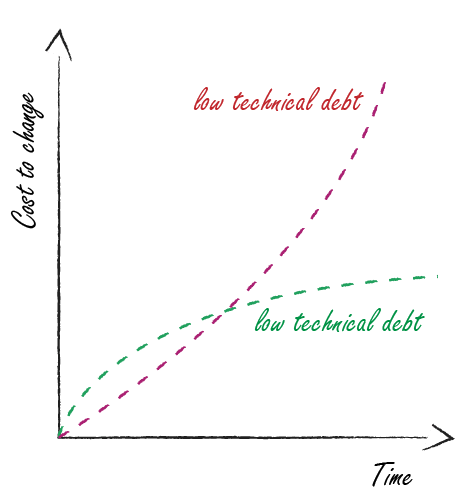Welcome to this comprehensive series on mastering scalability in software development, informed by over a decade of experiences and insights. Unlike your typical technical guide, this series is a collection of lessons learned from the trenches of software development. It’s not solely about code and technology; it’s about building software solutions together with others and making sure they grow healthy.
First, we’re laying the groundwork for understanding the team dynamics and cultural aspects that are essential for successful projects. And as we progress through the series, we’ll get more and more technical. Join me as we explore the principles that underpin robust software development, from agile workflows to architectural choices, from code quality to teamwork, all aimed at crafting apps that scale and adept to changing requirements.
Product delivery vs. discovery
As we embark on this journey into the world of building scalable and maintainable apps, it’s crucial to set the stage and make my intentions clear. What we’re about to explore in this series pertains to the realm of production-ready features — the kind of software that’s set to launch and provide real value to users.
However, it’s essential to distinguish this from the stages of product development, the phase known as “product discovery”. During this exploratory phase, our primary goal is to determine whether a feature holds value for users or whether a particular technical concept is feasible. This is where we employ methods like pretotyping, which helps us gauge a feature’s business value, or mockups and prototypes to test usability and technical feasibility.
In phases of product discovery, the quality of code can often take a back seat. In fact, I’d even go so far as to advocate a strategy that minimizes or avoids coding at all. The goal of product discovery is to generate knowledge as swiftly as possible with minimal effort.
This series of articles is all about how engineering within a product team can constantly ship production-quality software within the phases of product delivery. By this, I mean software that can easily adapt to changing requirements, can scale, and is easy to maintain.
Complexity
The very essence of engineering lies in mastering complexity. In my opinion, that is the decisive skill that differentiates junior software engineers from seniors. Developers with a hacking mentality and those that try to understand the root causes of problems and solve them with an appropriate design. Don’t get me wrong, hacking has an important place in product development. I have seen incredible things come out of hackathons that help to understand the potential of a solution. But when it comes to engineering, especially in the context of building scalable and maintainable software, hacking and quick fixes should be avoided at all costs. Usually, hacks, quick fixes or shortcuts will come back in a very unexpected way. Why?
Because software systems can become incredibly intricate, especially as they evolve and grow. Complexity arises due to the interplay of various components and subsystems, which, when left unchecked, can lead to unpredictable behavior and a gradual decline in development velocity. These interactions can give rise to what we call “emergent behavior” - those unexpected quirks that seem to multiply with each new feature we introduce. If you have ever heard about the butterfly effect, then this is what I am talking about. Hacks and shortcuts are the butterflies in code, and their impact on the speed of development is nothing short of remarkable.
These interactions can give rise to what we call “emergent behavior” - those unexpected quirks that seem to multiply with each new feature we introduce. If you have ever heard about the butterfly effect, then this is what I am talking about. Hacks and shortcuts are the butterflies in code, and their impact on the speed of development is nothing short of remarkable.
Handling complexity with proper architecture and not through hacks or shortcuts is the key to maintaining a swift pace in development. This is the very essence of our craft.
The Role of Architecture and Design Principles
Architecture and design principles play a pivotal role in managing complexity and minimizing emergent behavior. These principles guide us in creating systems that exhibit deterministic and predictable behavior. When left unchecked, a lack of architectural discipline can lead to unpredictable interactions, system quirks, and gradual declines in development speed.
Technical debt is the term we use to describe the consequences of taking shortcuts, implementing quick fixes, or neglecting proper design and architecture. As technical debt accumulates, system complexity rises, resulting in higher costs for making changes. In the agile development landscape, where adaptation to changing requirements is crucial, the ability to manage technical debt is a make-or-break factor. Allowing complexity to soar in your codebase can quickly impede your business’s agility.
Effective architectural decisions, such as modularization and well-defined interfaces, help minimize interactions and dependencies between different parts of a system. This, in turn, makes the codebase more manageable, maintainable, and less prone to emergent behavior.
At the outset of every project, establishing infrastructure and architecture may seem like overengineering, potentially slowing down the initial development pace. However, it’s essential to recognize that this isn’t about short-term gains. The true value of these measures becomes evident as the project advances, helping to tackle increasing complexity and minimize technical debt.
Remember, we want to play the long game here. This means being able to adapt software to changing requirements and not spending your days tracking down bugs until the project runs out of money.
Building Scalable Apps with Flutter
While my focus is broad, I value practical application. While we will explore fundamental principles that can be applied in any programming language, I’ll provide concrete examples using Flutter and Dart to demonstrate how these principles come to life.
Topics to Cover in the Series:
Cultivating Successful Projects: Part I, Team Dynamics and Growth: Team Dynamics and Growth: In this first part, we explore why healthy team dynamics are the foundation for any project to grow successfully.
Cultivating Successful Projects: Part II, Technical foundation: Next, we explore best practices in project setup, including version control with git, merge strategies, and the use of semantic Pull Requests.
Maintaining Quality : In the third part, we explore the role of continuous integration in software development. How it can streamline development workflows and how it helps to enforce quality standards within development teams.
S.O.L.I.D. Principles : Here, we explore the software design principles that form the foundation of robust and easily maintainable code.
Domain Driven Design : Up next, we explore Domain-Driven Design, a powerful approach that ensures software effectively mirrors real-world concepts.
Clean Architecture : In this part, we are going to explore the concept of Clean Architecture and how it helps create modular, maintainable, and scalable software.
Test Driven Development : Would you like to have confidence in your solution and avoid regression? Learn about Test Driven Development (TDD) and how it improves the reliability and maintainability of your code.
Dependency Injection : Alongside TDD, we discover the importance of Dependency Injection and its role in creating flexible and testable code.
Null Safety : Tony Horare calls his invention of Null references the “billion-dollar mistake”. Luckily, many modern languages offer null safety, and we will explore how these techniques can avoid runtime errors in your applications.
Functional Reactive Programming : When many things happen simultaneously and asynchronously, complexity easily explodes. In this section, we explore how Functional Reactive Programming helps to efficiently manage complex interactions and data flows.
Immutability : Trust the data that you are dealing with. Here, we dive into the concept of immutability and how it promotes predictability and helps prevent subtle bugs.
Functional Error Handling : Try and catch? Certainly, but how and where? In the final installment of this series, we explore an effective strategy for managing errors.







Top comments (0)